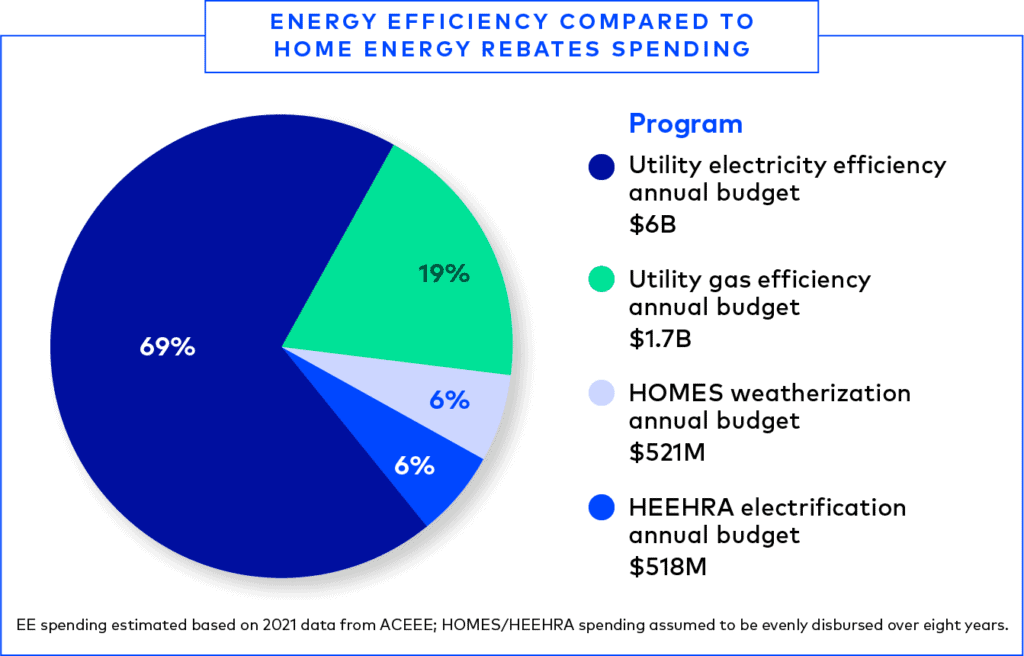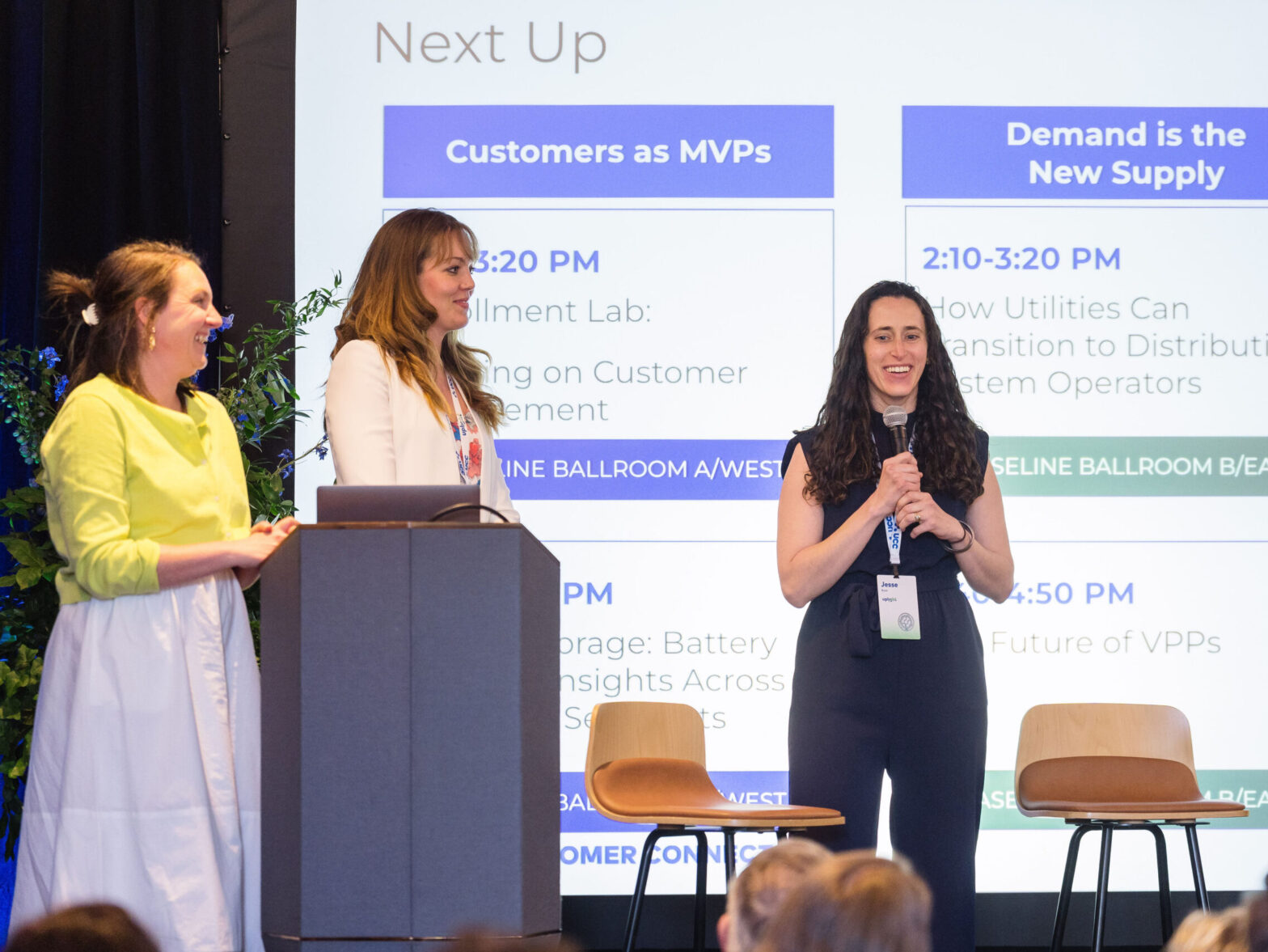Electrification is coming. With the launch of the federal Home Energy Rebates programs, residents have an unprecedented opportunity to weatherize and electrify their homes. States across the country are busy preparing federal applications to the U.S. Department of Energy to get their fair share of the $8.8 billion investment. Deploying those funds efficiently is arguably the biggest opportunity (and challenge) in 2024 to facilitate a successful energy transition.
While the federal Home Energy Rebates program represent a significant and welcome investment to supercharge weatherization and electrification deployment, its weatherization (HOMES) and electrification (HEEHRA) programs make up only a fraction of the overall efficiency funding offered by gas and electric utilities today. We estimate that the annual contribution of HOMES and HEEHRA programs will account for only approximately 6% each of the total utility efficiency and electrification investments across the U.S. (see the chart below). This fact underscores the importance of aligning the relatively small, but important, injection of federal funds with existing utility programs.

Electricity and gas efficiency spending is sourced from the ACEEE’s most recent 2022 State Energy Efficiency Scorecard. HOMES and HEEHRA data is sourced from the U.S. Department of Energy November 2, 2022 press release.
The Home Energy Rebates programs present an interesting opportunity for utilities and regulators. Specifically, how should utilities work with state energy offices (SEOs) to help customers take advantage of whole home weatherization and electrification rebates–and thus save money, create healthier environments, improve home comfort, and reduce carbon emissions?
The Current State of Affairs
Though DOE encourages SEOs and utilities to work together, there is no requirement under the Home Energy Rebates programs to do so. And there are a lot of reasons utilities and SEOs may wish to run separate programs–ranging from utility concerns about attribution of savings, the lack of staff capacity to coordinate on program requirements, and concerns over regulatory authority. These are real concerns, which can and should be addressed. However, the failure of SEOs and utilities to collaborate effectively in rolling out federal energy dollars will represent an enormous missed opportunity to stack incentives, electrify homes, and best serve customers.
The Critical Role of Utilities
Utilities are generally well-known and trusted by customers, making them the natural choice to deploy energy incentives. Research consistently shows that customers are more likely to associate and engage with their utility (rather than a state energy office) on all things related to energy.
Recent research commissioned by Uplight underscores this point. In a general population survey, we asked over 1,000 energy users about their perceptions of utility energy programs relative to other clean energy providers (e.g., big box stores, solar providers, or technology firms, among others). Notably, consumers perceive utilities to be trustworthy (ranking near the top third of service providers). They also view utilities as the best service provider to help them manage their energy decisions and devices in their homes.
But, collaboration is hard. Aligning utilities, regulatory authorities, state energy offices, industry leaders, and policymakers to enable robust implementation of billions of dollars is no small feat. Nonetheless, most energy policy and market experts point out that the benefits of collaboration are worth the effort.
For example, the nonprofit think tank Rocky Mountain Institute reports that coordination among government and industry stakeholders is critical to spur growth of the electrification market. According to RMI, the most successful SEOs will work with utilities and local governments to create “contractor- and consumer-friendly one-stop-shop retrofit programs” that provide consumers with information on all available incentives and simplify administration across state, utility, and local programs.
Similarly, Center for American Progress recommends that SEOs “centralize all rebate-related points of contact and merge consumer-facing programs between utilities and state energy offices to ensure application accessibility and maximize resident participation.”
Putting the Customer at the Center
These think tanks know that successful programs place the customer at the center of the experience. This is a foundational tenet for any successful energy initiative, and electrification is no exception. For an initiative as far-reaching as the Home Energy Rebates programs, this customer-focused mindset is even more important.
A lack of customer-centricity results in unwieldy consumer programs with inadequate marketing and education and onerous application requirements. On top of this, implementing new, stand-alone energy programs that are not integrated with existing utility EE and electrification offerings creates confusion, stymieing customer participation and overall program impact.
The Home Energy Rebates programs offer an unprecedented opportunity to improve our existing weatherization and electrification program deployment models. We already know that there are opportunities for improvement in weatherization and electrification programs. In a recent survey, Uplight asked customers to describe their awareness and engagement with EE and electrification programs. We found that:
Overall there is a perception gap between what [energy programs] offer and what programs people are aware of. There are relatively low levels of participation across programs, with varying levels of familiarity. There are also some key demographics, namely those identifying as female and older people, who have less familiarity with current programs.
These are challenges found across all energy programs, regardless of the provider. Historically, the energy efficiency and electrification marketplace has been highly fragmented with different programs and incentive providers, all of whom are competing to get customers’ attention. To address these challenges, there must be a greater focus on utilities, government agencies, program administrators, non-profits, and other service providers collaborating behind the scenes to create a connected customer journey.
The Connected Customer Journey
What exactly is a connected customer journey you may ask?
At Uplight, we describe a connected customer journey as a low-friction engagement and activation process from initial customer outreach through to installation and orchestration of energy systems. A connected customer journey has five key elements. It:
- Provides customers with the information and recommendations they need to make smart energy choices (via online energy portals, coordinated outbound messaging, etc.).
- Consolidates multiple steps of the buying journey into one action via a central online marketplace (e.g., product information, rebate processing, qualification, program enrollment, etc.).
- Connects and applies rebates and incentives across programs for the same program or product (where allowed) for easy adoption by the customer.
- Extends the customer journey to include non-utility channels (e.g., online vendors, big box stores), thereby increasing customer accessibility to services and products.
- Matches the customer to the full suite of energy products and services (e.g., EE, electrification, and demand response (DR) education, installation, and maintenance) to help them take the next right step.
We believe the utility is the natural provider for energy efficiency and electrification programs. Utilities are better positioned than almost any other stakeholder to manage the customer journey successfully. Moreover, utilities in most states have already spent billions of dollars to establish the program infrastructure necessary to run a connected customer journey for energy efficiency and electrification. And utilities have long-term and stable funding sources (like ratepayer surcharges) to maintain those programs over time. Utilities also have valuable customer data, existing customer relationships, and incentives that could be stacked on top of federal funding to supercharge deployment.
We Cannot Afford to Get It Wrong
We cannot afford to get weatherization and electrification under the Home Energy Rebates programs wrong. Utilities are (in most states) the best-positioned organization to deploy federal weatherization and electrification funds. Implementation must be done in coordination with SEOs, of course. But the last thing that customers need is ANOTHER energy program with a different administrator and different program requirements to sort through as they consider options for home energy upgrades.
As a result, we believe that it is in the best interest of consumers for SEOs to work closely with utilities–or even disburse Home Energy Rebates funding directly to utilities for implementation. In other words, Home Energy Rebates program funds should be fully integrated into utilities energy efficiency and electrification initiatives.
We believe it is incumbent on regulators and state policymakers to make this expectation known. And it is incumbent on utilities and SEOs to collaborate to provide the best experience for their residents and customers.
At the end of the day, a truly connected electrification customer journey, led by utilities, will result in more customers with electrified and efficient homes.




